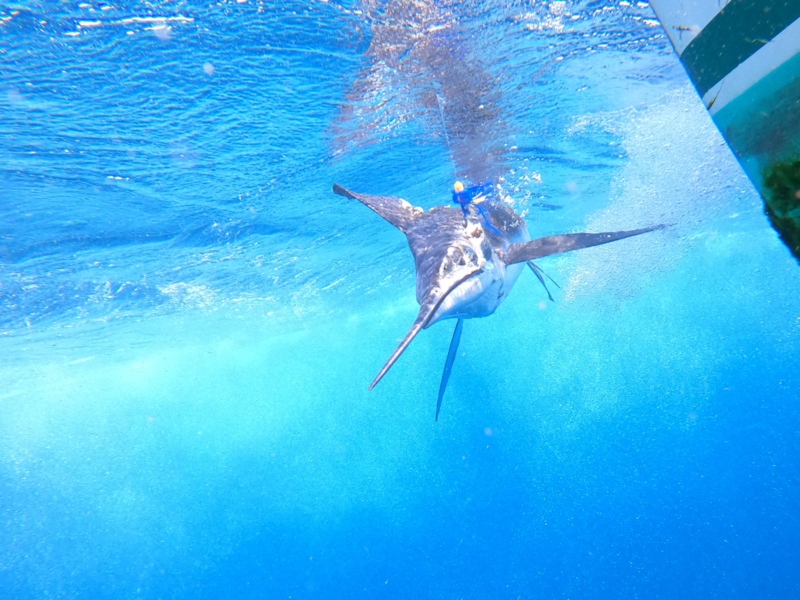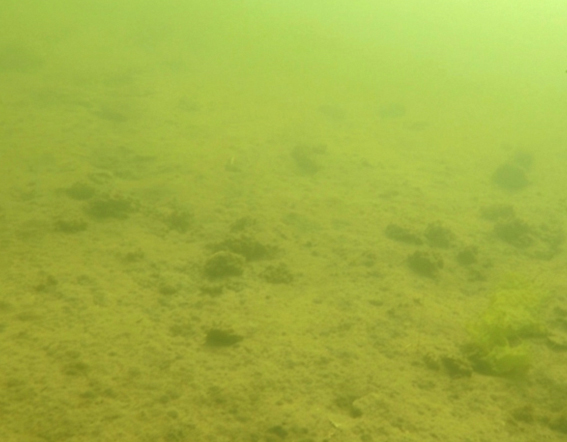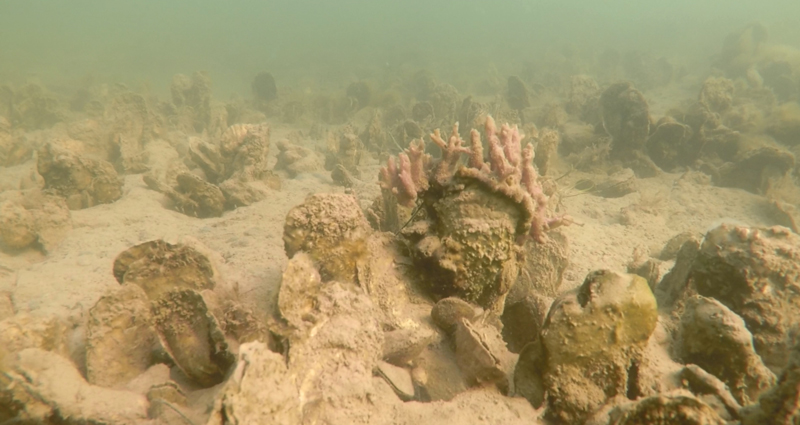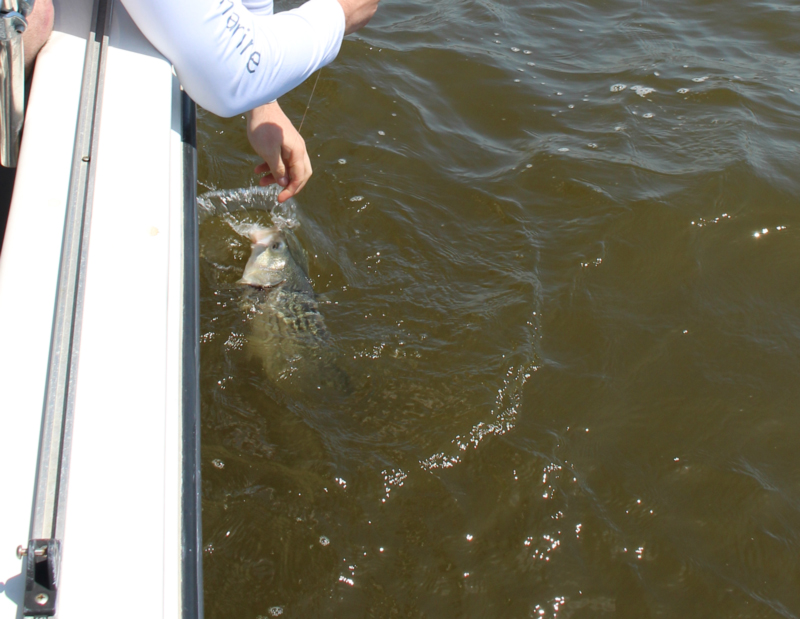Forty-one years reef fishing out of Ocean City, Maryland now. Never know when checkout time is, but I’d sure like to see a bluer ocean before my time’s up.
It’s 100-percent doable. Repairing the Mid-Atlantic’s marine water quality is not an unobtainable goal. There’s already an army of people working on it, including the Army Corps of Engineers. In fact, I’d have about sworn we were seeing a small improvement in the ocean, owing to fantastic successes in oyster restoration. That water’s moving on now, and thoughts of “we’re winning” need to be tempered with a realization of 70 years of decline. Any comparison to assert better water quality we might make today is sorely tainted by generational shift. Each generation accepts their own marine water as normal. For this reason, when an improvement is noted it’s seen as phenomenal — a “Wow!” moment despite conditions incredibly worse than in the decades, much less centuries, past. The greening of the Mid-Atlantic has happened slowly and passing decades have numbed our realization: the loss of blue water along the Mid-Atlantic has been a long, slow, multi-generational decline.


White marlin tell the tale fairly simply. Capt. Jay Coleman used to frequent the Angler restaurant for breakfast in the early 1980s when I worked deck on a partyboat there. In those days releasing white marlin was still contentious. Capt. Jay would exclaim, “What good is it to throw em back? The blue water’s gone!”
I heard him say it many times, not just the inshore shoals of Winter Quarter, SouthEast Ridge, and the Jackspot, all roughly 20 miles out and all once frequently targeted by charter skippers for white marlin. Capt. Jay felt we’d lost the ocean entirely, that we couldn’t win. But our greening sea is now a lot worse than in Capt. Jay’s time.
Another example: Capt. Jerimiah Kogan began a dive boat business about 20 years ago. He used to take newly certified divers to shallow artificial reefs at Great Gull Shoal some five miles out. They had green water, sure, but not so dense with algae that they couldn’t see. Those new divers even spearfished successfully. Wasn’t a decade gone by, however, and Capt. Jerimiah could no longer take his dive clients so close. He had to go 10 miles to what is now the outside edge of the Bass Grounds artificial reef site, just so his divers could see. Ocean water quality, once pristine just a handful of miles from the beach, has grown steadily worse since the 1950s. Now, as it has been in the Chesapeake so very much longer, visibility in the nearshore ocean is closing to zero.
Most of the folks slaving away at Bay restorations in our region, professionals and volunteers alike, haven’t any idea they’re doing anything other than estuary and river works. They’re trying to make Delaware Bay or Chesapeake waters clear and alive. It’s a wonderful effort, and I wish they all knew they’re also all working to turn the ocean blue, too.
I believe the greatest benthic-pelagic ecological coupling in the Mid-Atlantic is the bond between white marlin and oysters. Oysters do not grow in the ocean. Marlin do not enter the Chesapeake or Delaware Bays (at least not for a very long time!). Yet they’re very much connected ecologically. As oyster populations declined to their lowest levels in the late 1970s, the loss of our region’s vital biofilter not only created changes to our region’s estuarine water quality, but our oceanic water quality as well. When the wild oyster fishery became fully unsustainable owing to disease and overharvest, the greening of the Mid-Atlantic Ocean accelerated.


Sixty and 70 years ago marlin were commonly caught just five to 20 miles offshore. They’re now rarely targeted inside 55 miles. The solution fishermen sought, quite practical for marlin fishing enthusiasts with deep pockets, was to build faster and bigger boats. In recent years some boats have been known to run over 100 miles from Ocean City Inlet to get good action.
Yet conservation and management of white marlin has worked. Just in the last decade there have been records set for most white marlin caught in a day, and in a year. Their disappearance inshore is habitat-related, not population-related. Thus, fishery management’s controls of catch and season are of no use in restoring marlin to their inshore grounds. We’ve got to repair the failed habitat, the greening water, that pushed ‘em off.
I spoke with one skipper who was among the first to fish Ocean City’s brand-new inlet in 1934. He told me they’d put lines in at the five-mile buoy (Great Gull Shoal) and troll to Fenwick Island Buoy, about 10 miles north and four miles offshore. Day after day, marlin trips four or five miles offshore. They must have been fishing blue water. Had to.
Capt. Jack Kaeufer put a live marlin on Talbot St. dock in 1969. The billfish was one of two his party caught just five miles out at Great Gull Shoal. A marlin still flopping about on the scale is unimaginable nowadays. Capt Jim Whaley told me of winning the Marlin Club tournament in 1958 with a white he caught nine miles out on the outside edge of the Bass Grounds — a huge area of natural reef we’d lose before another two decades had passed. Once a reef best measured as roughly four and a half square miles, today you could measure what remains of that natural reef in square yards.
Going back in time a full century, Irv Mumford, Sue Foster’s father, told Marty Gary and me how his father had worried about white marlin wrecking bluefish trolling gear while commercial fishing from surf-launched, one-cylinder engine boats in the 1920s. They used horse-drawn, surf-launched boats to catch bluefish, in demand by local hotels, and feared marlin just two miles out…
Now, here is where some readers may become confused. My efforts at marine seafloor restoration and improvement are about recreating reef habitat vital to the spawning of ocean reef species such as sea bass, tautog, and summer flounder. But restoring white marlin to where Capt. Jim caught his tournament winning fish just nine miles out is about Chesapeake and Delaware Bay oysters; about naturally filtered water leaving our estuaries; about putting back our region’s two huge biofilter systems; about restoring the oyster bars and reefs of a century and more ago so that the ocean is no longer overfilled with nutrients and algae.

Unfortunately, repairing our greening sea isn’t on NOAA’s to-do list. Where algae and excess nutrients are concerned, even today many scientists still believe “the ocean just absorbs it.” I actually heard one of the smartest marine ecologists I’ve ever met say exactly that to a room full of scientists. He showed all the issues with algae and water quality on a chart of the Chesapeake via PowerPoint; had a line drawn across the mouth of the Chesapeake Bay as if to say “our work stops here” because “the ocean just absorbs it.” Nearly all scientists seem to believe that where over-nutrification is concerned, the Atlantic Ocean can handle the Delaware and Chesapeake Bays’ outflows without a hitch.
But it can’t. It hasn’t.
If our ocean waters off DelMarVa were to have gone from their beautiful blue to pea-green suddenly and in only a year or two, there’d be one heck of an environmental commotion. But no. We’re used to it. Dern sure ought to be a concern. Our ocean is ill. I fear government won’t grasp the wholeness of it until the ocean’s health starts shaving billions off the coastal beach’s summer economy. Then, maybe it’ll get some attention.
In August of 2019, with a hurricane shutting down fishing, my crew and I made a prototype for a two-man portable, rapidly assembled reef unit mold, using poured cement to make a 160-pound pyramid. I tried to design it to avoid scouring in too, so sand passes through instead of building up and burying units.
Now we have roughly 40 fiberglass molds and will build more this winter. There’s no patent. If you or your dot-org or dot-com want to make molds to use, have at it. Beginning with Atlantic Concrete in Dagsboro, DE, and Bear Concrete in Bear, DE, (plus a bunch in my backyard made with bagged cement) we deployed over 300 pyramids that first year with only 14 molds. Today our 40-some molds are now spread out among four more plants and job sites including two sites with Gillis Gilkerson, and two others who desire anonymity. We’ve just crossed a threshold where units can be collected via tractor trailer load and sent to reef deployment projects around the Mid-Atlantic.
That’s with 40 molds. What might we accomplish with 120? With 300? Should a cement plant in West Virginia want to participate, would a full trailer load of pyramids not be worth the expense of trucking to a site on the Chesapeake’s western shore?
One hundred twenty reef pyramids have been deployed off the CCA-MD reef at Janes Island in the Chesapeake. Those were the first reef pyramids of what I sincerely hope will become tens of thousands deployed for oyster restoration. We must re-reef the Mid-Atlantic to successfully restore fisheries that most of today’s generation have no idea we’ve lost.
Does the opening to this article make more sense now? We’ve recently begun to use cement plant and truck wash-out to turn the Mid-Atlantic Ocean blue again. If you’d care to help with our efforts, visit or donate at the OC Reef Foundation. You might also visit the CCA-MD Building Conservation Trust for habitat. Those monies go into oyster restoration. The monster green orgs like the Chesapeake Bay Foundation and The Nature Conservancy work on it, too. Inquire how to make sure your donation goes into a shirtsleeves-up oyster effort and not a “teach children what we should have done” program. Then too, state and federal projects abound. Some are quite huge and, recently, successful. Write your representatives about funding those that work.
Very few of them have any idea that the ocean has turned green.
-By Capt. Monty Hawkins